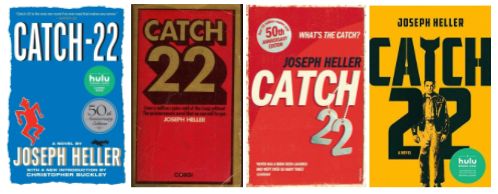By: Emily Getty
Catch-22 is a World War II novel like no other. Set on a made-up Italian island, it follows the story of Captain John Yossarian, a bombardier in the United States Air Force that desperately wants to not die, but the infamous Catch-22 makes it impossible to escape service. Catch-22 states that if a man is insane he should not be flying missions and needs only to ask for removal from flight duty, but as soon as he does so he is deemed sane for not wanting to fly more missions and is therefore denied leave. Heller’s circular arguments and hilarious irony throughout the novel portrays Yossarian and his friends’ plight in a way that is both uproariously funny and deeply disturbing. The novel leaves readers with thoughts about war that have never crossed their minds before.
Catch-22 was first published in 1961 by Simon & Schuster. When it was first released, the novel had mixed reviews. Members of the younger generation immediately adored it, as it fit perfectly with their anti-war opinions as the Vietnam War entered the public eye. However, other readers were offended with the irreverent way Heller handled the topic of war, feeling that he did not treat the issue seriously enough. The novel eventually gained popularity, and while it did not win any awards, it is widely recognized as one of the best novels of its generation. It was adapted into a movie in 1970 and a Hulu series in 2019. The novel was banned once and had two major challenges brought against it. The banning occurred in Strongsville, Ohio, where the book was removed from the school library in 1972. The primary reason for this removal, according to the school, was profane and inappropriate language. Four years later the book was returned after a small group of students appealed the school district’s decision in the court case Minarcini v. Strongsville City School District. The challenges were brought against the book in Dallas, TX in 1974 and Snoqualmie, WA in 1979. The challenge in Snoqualmie was raised due to the many references to women as “whores.”
“There was only one catch and that was Catch-22, which specified that a concern for one’s safety in the face of dangers that were real and immediate was the process of a rational mind. Orr was crazy and could be grounded. All he had to do was ask; and as soon as he did, he would no longer be crazy and would have to fly more missions. Orr would be crazy to fly more missions and sane if he didn’t, but if he was sane he had to fly them. If he flew them he was crazy and didn’t have to; but if he didn’t want to he was sane and had to. Yossarian was moved very deeply by the absolute simplicity of this clause of Catch-22 and let out a respectful whistle.
“That’s some catch, that Catch-22,” he observed.
“It’s the best there is,” Doc Daneeka agreed.”
Joseph Heller, Catch 22

About The Author
Joseph Heller, like his protagonist Yossarian, was a bombardier in the American Air Force. He flew 60 missions in Europe before attending Columbia University to get his M.A. and University of Oxford as a Fulbright Scholar. His experiences in the war greatly affected his point of view and largely influenced his writings. After the war was over he married Shirley Held, with whom he had two children, Erica and Theodore. He worked several jobs over the years, including teaching at Pennsylvania State University, working as an advertising copywriter for a few different magazines. From 1958-1961, Heller worked as a promotion manager while writing Catch-22, his first novel, in his spare time. While by far his most successful novel, Heller wrote other books, including Good as Gold, God Knows, Closing time, which is a sequel to Catch-22, and an autobiography entitled Now and Then: From Coney Island to Here. Heller divorced his wife in 1981, and later remarried to Valerie Humphries, a nurse of his when he was diagnosed with and treated for Guillain-Barré Syndrome. He died in his home of a heart attack in 1999.
Further Reading
https://www.npr.org/2011/10/13/141280833/catch-22-a-paradox-turns-50-and-still-rings-true
https://digitalrepository.trincoll.edu/cgi/viewcontent.cgi?article=1287&context=theses
https://www.theatlantic.com/entertainment/archive/2019/05/catch-22-review-hulu/589687/